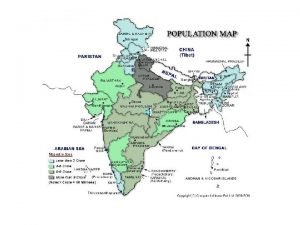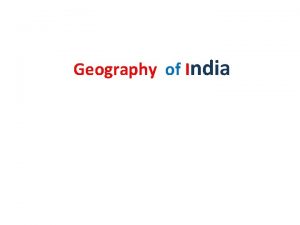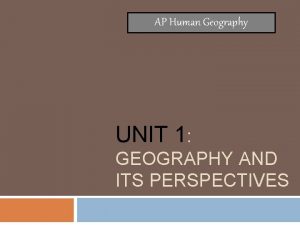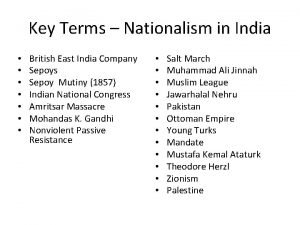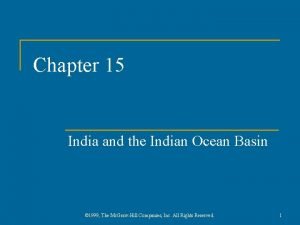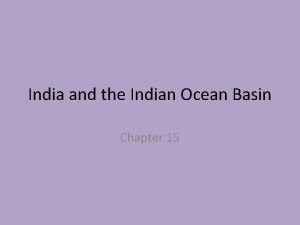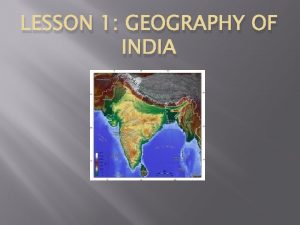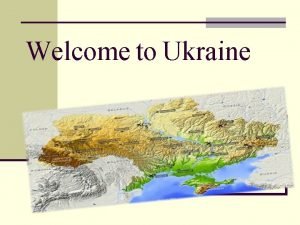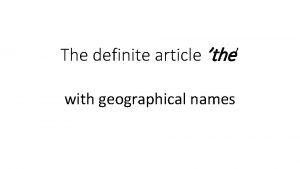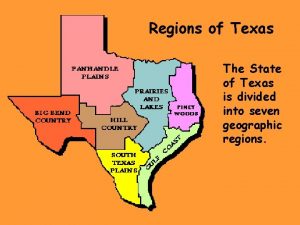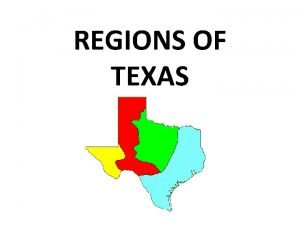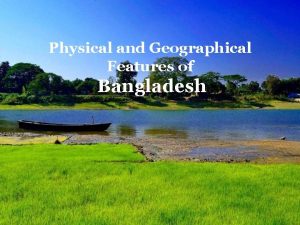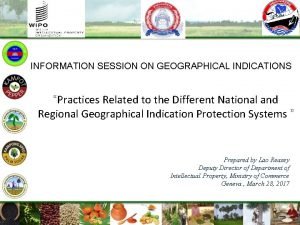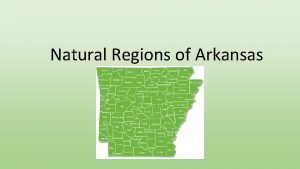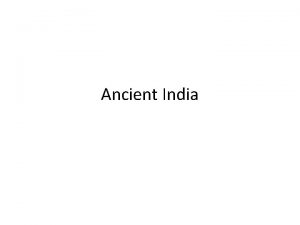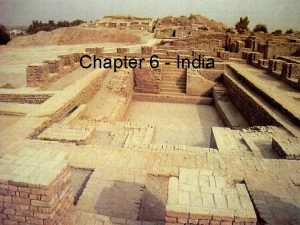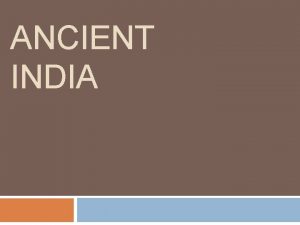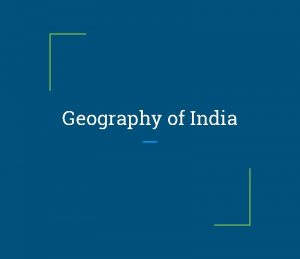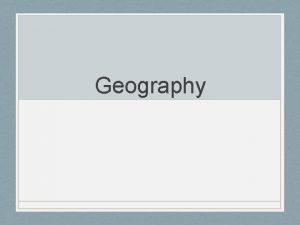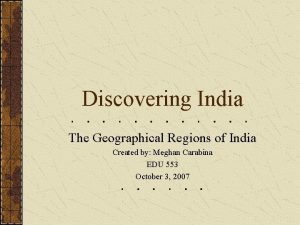Geography of India Location setting Indian Geographical Location



































- Slides: 35

Geography of India

Location setting • Indian Geographical Location • Lying between latitude 8° 4′ N to 37° 6′ N and from longitude 68° 7′ E to 97° 25′ E, the country is divided into almost equal parts by the Tropic of Cancer (passes from Jabalpur in MP). • The southernmost point in Indian Territory, (in Great Nicobar Island) is the Indira Point (6° 45′), while Kanyakumari, also known as Cape Comorin, is the southernmost point of Indian mainland. The country thus lies wholly in the northern and eastern hemispheres. • The 82° 30′ E longitude is taken as the Standard Time Meridian of India, as it passes through the middle of India (from Naini, near Allahabad).

• Area Geography & Boundaries Geography • India stretches 3, 214 km from North to South & 2, 933 km from East to West. • Geography Area of India : 32, 87, 263 sq. km. Accounts for 2. 4% of the total world area and roughly 16% of the world population. • Mainland India has a coastline of 6, 100 km. Including the Lakshadweep and Andaman and Nicobar Islands, the coastline measures about 7516. 6 km. • In India, of the total land mass: – – Plains Geography: 43. 3% Plateaus: 27. 7% Hills: 18. 6% Mountains Geography: 10. 7% • In the South, on the eastern side, the Gulf of Mannar & the Palk Strait separate India from Sri Lanka. • Total land neighbours : 7 (Pakistan, Afghanistan, China, Nepal, Bhutan, Bangladesh and Myanmar). • India’s Islands include the Andaman & Nicobar Islands in Bay of Bengal and Lakshadweep, Minicoy & Amindive Islands in the Arabian Sea.

Drainage system • • The Indus System It has a total length of 2880 km (709 km in India). Rises in Tibet (China) near Mansarovar Lake. In Jammu and Kashmir, its Himalayan tributaries are: Zanskar, Dras, Gartang, Shyok, Shigar, Nubra, Gilgit, etc. Its most important tributaries, which join Indus at various places, are: Jhelum (725 km), Chenab (1800 km), Ravi (720 km), Beas (470 km) & Sutlej (1050 km). Sources: Jhelum from Verinag (SE Kashmir), Chenab from Bara Lacha Pass (Lahaul. Spiti, H. R), Ravi from Kullu Hills near Rohtang Pass in H. R, Beas from a place near Rohtang Pass in H. E and Satluj from Mansarovar – Rakas lakes in W. Tibet. In Nari Khorsan province of Tibet, Satluj has created an extraordinary canyon, comparable to the Grand Canyon of Colorado (US). According to the Indus Water Treaty signed between India and Pakistan in 1960, India can utilize only 20% of the total discharge of Indus, Jhelum and Chenab.

The Ganga System • The Ganga System • It is 2525 km long of which 1450 km is in Uttarakhand UP, 445 km in Bihar and 520 km in West Bengal. • The Ganga, the head stream is constituted of two main rivers – Bhagirthi and Alaknanda, which combine at Devprayag to form Ganga. • Before Alaknanda meets Bhagirthi at Devprayag, Mandakini meets Alaknanda at Rudraprayag. • Sources: Bhagirthi from Gaumukh, Alaknanda from Badrinath, Mandakini from Kedarnath (all from Uttarakhand). • Yamuna (1375 km) is its most important tributary (on right bank). It rises at the Yamunotri glacier in Uttarakhand. It runs parallel to Ganga for 800 km and joins it at Allahabad. Important tributaries of Yamuna are Chambal (1050 km), Sind, Betwa (480 km) and Ken (all from south). • Apart from Yamuna, other tributaries of Ganga are Ghaghra (1080 km), Son (780 km), Gandak (425 km), Kosi (730 km), Gomti (805 km), Damodar (541 km). Kosi is infamous as ‘Sorrow of Bihar’, while Damodar gets the name ‘Sorrow of Bengal’ as these cause floods in these regions. • Hooghli is a distributory of Ganga flowing through Kolkata.

The Brahmaputra system • The Brahmaputra system • It has a total length of 2900 km. It rises in Tibet (from Chemayungdung glacier), where it is called Tsangpo, and enters the Indian territory (in Arunachal Pradesh) under the name Dihang. • Important Tributaries: Subansiri, Kameng, Dhansiri, Manas, Teesta. • In Bangladesh, Brahmaputra is known by the name of Jamuna while Ganga gets the name Padma. Their combined stream is known as Padma only. Meghna is the most important distributory before it enters the Bay of Bengal. • The combined stream of Ganga and Brahmaputra forms the biggest delta in the world, the Sundarbans, covering an area of 58, 752 sq. km. Its major part is in Bangladesh. • On Brahmaputra is the river island, Majuli in Assam, the biggest river island in the world. • Brahmaputra, or the Red River, is navigable for a distance of 1384 km up to Dibrugarh and serves as an excellent inland water transport route.

Peninsular drainage • A. East Flowing Rivers of India (or Delta forming rivers) • Mahanadi River (858 km) : Rises in Raipur distt. in Chhatisgarh. Main tributaries: lb, Seonath, Hasdo, Mand, Jonk, Tel, etc. • Godavari River (1465 km) : Also called Vriddha Ganga or Dakshina Ganga. It is the longest peninsular river. Rises in Nasik. Main tributaries: Manjra, Penganga, Wardha, Indravati, Wainganga, Sabari, etc. • Krishna River (1327 km) : Rises in Western Ghats near Mahabaleshwar. Main tributaries: Koyna, Dudhganga, Panchganga, Malprabha, Ghatprabha, Bhima, Tungabhadra, Musi, etc. • Cauvery River (805 km) : It is the largest peninsular river (maximum amount of water). Infact, it is the only peninsular river which flows almost throughout the year. Known as the ‘Ganga of the South’. It rises from the Brahmagir range of Western Ghats. Main tributaries: Hemavati, Lokpawni, Shimsa. It is less seasonal than others as its upper catchment area receives rainfall during summer by the S. W monsoon and the lower catchment area during winter season by the retreating N. E. monsoon. Its 90% – 95% irrigation and power production potential is already being harnessed. • Swarnarekha River (395 km) and Brahmani (705 km) : Rises from Ranchi Plateau.

• B. West Flowing Rivers in India • Narmada River (1057 km) : Has only l/10 th part in Gujarat. Rises in Amarkantak Plateau and flows into Gulf of Khambat. It forms the famous Dhuan Dhar Falls near Jabalpur. Main tributaries: Hiran, Burhner, Banjar, Shakkar, Tawa, etc. • Tapti River (724 km) : Rises from Betul distt in MR Also known as twin or handmaid of Narmada. Main tributaries: Purna, Betul, Arunavati, Ganjal, etc. • Sabarmati River (416 km) : Rises from Aravallis in Rajasthan. • Mahi River (560 km) : Rises from Vindhyas in MR • Luni River (450 km) : Rises from Aravallis. Also called Salt River. It is finally lost in the marshy grounds at the head of the Rann of Kuchchh. • Sharavati is a west flowing river of the Sahyadris. It forms the famous Jog or Gersoppa or Mahatma Gandhi Falls (289 m), which is the highest waterfall in India.

Inland Drainage • • • • Inland Drainage Some rivers of India are not able to reach the sea and constitute inland drainage. Ghaggar (494 km) is the most important of such drainage. It is a seasonal stream which rises on the lower slopes of the Himalayas and gets lost in the dry sands of Rajasthan near Hanumangarh. It is considered the old Saraswati of the Vedic times. Note: The largest man-made lake in India is Indira Sagar Lake, which is the reservoir of Sardar Sarovar Project, Onkareshwar Project and Maheshwar Project in Gujarat-MP. Chilka Lake (Orissa) is the largest brackish water lake of India. Otherwise also, it is the largest lake of India. Wular Lake (J & K) is the largest fresh water lake of India. Dul Lake is also there in J & K. From Sambhar and Didwana Lake (Rajasthan), salt is produced. Other important lakes are Vembanad in Kerala and Kolleru & Pulicat in AP. The three important Gulfs in the Indian Territory are: Gulf of Kuchch (west of Gujarat) : Region with highest potential of tidal energy generation Gulf of Cambay or Gulf of Khambat (Gujarat) : Narmada, Tapti, Mahi and Sabarmati drain into it. Gulf of Mannar (south east of Tamil Nadu) : Asia’s first marine biosphere reserve.

Physiography of India • Physiography of India – Indian States on International Boundaries • Indian Physiography • Physiographically, India can be divided into 3 units: • Mountains in the North • Plains in the Northern India & the Coast • Plateau region of the South • To these can be added the fourth, namely, the coasts and islands

Mountains of India • The Himalayas in India • Means ‘Abode of Snow’. They are one of the youngest fold mountain ranges in the world and comprise mainly sedimentary rocks. • They stretch from the Indus River in the west to the Brahmaputra River in the east. Total length is about 5000 km. The width of the Himalayas varies from 500 km in Kashmir to 200 km in Arunachal Pradesh. Their average height is 2000 m. The Eastern Himalayas-made up of Patkai Hills, Naga Hills, Mizo Hills and the Garo, Khasi and Jaintia Hills-are also known as Purvanchal. • The Pamir, popularly known as the Roof of the World, is the connecting link between the Himalayas and the high ranges of Central Asia. • Can be divided into 3 parallel or longitudinal zones, each with separate features.

The Great Himalayas or The Himadri Average elevation extends upto 6000 m & some of the world’s highest peaks are here Mt Everest (or Sagarmatha or Chomo Langma) 8850 m (in Nepal) Mt Kanchenjunqa 8598 m (in India) Mt Makalu 8481 m (in Nepal) Mt Dhaulaqiri 81 72 m (in Nepal) Mt Cho Oyu 8153 m (in Nepal) Mt Nanga Parbat 8126 m (in India) Mt Annapurna 8078 m (in Nepal) Mt Nando Devi 7817 m (in India)

Passes • There are few passes and almost all of them have a height above 4, 500 m. they include Shipki La and Bara Lapcha La in Himachal Pradesh, Burzil and Zozi La in Kashmir, Niti, Lipulekh and Thag La in Uttarankhand, and Jelep La and Nathu La in Sikkim.

• Lesser Himalayas or The Himachal • Average height of mountains is 3700 – 4500 m. • Mountains and valleys are disposed in all direction (mountains rising to 5000 m and the valleys touching 1000 m). • Its important ranges are : Dhauladhar, Pir Panjal, Nag Tibba, Mussoorie. • Important hill resorts are : Shimla, Chhail, Ranikhet, Chakrata, Mussoorie, Nainital, Almora, Darjeeling.

• Outer Himalayas or The Shiwaliks • Lowest range (average elevation is 900 -1200 m). • Forms the foothills and lies between the Lesser Himalayas and the plains. It is the newest range. • Trans – Himalayan Zone • This range lies to the north of the Great Himalayas. It has some important ranges like Karakoram, Laddakh, Zanskar, etc. the highest peak in this region is K 2 or Godwin Austin (8611 m, in Pak occupied Kashmir). Other high peaks are Hidden Peak (8068 m), Broad Peak (8047 m) and Gasherbrum II (8035 m). • The longest glacier is Siachin in the Nubra valley, which is more than 72 km long (biggest glacier in the world). Biafo, Baltaro, Batura, Hispar are the other important glaciers in this region. • This area is the largest snow-field outside the Polar Regions.

Peninsular Mountains • While the Himalayas are Fold Mountains, they are not. • The Aravalli Mountains (Rajasthan) : World’s oldest. Guru Shikhar is the highest peak on which Mount Abu (1, 722 m) is situated. • The Vindhya Mountains • The Satpura Mountains (highest point at Dhupgarh [1, 350 m] near Pachmarhi) • The Western Ghats or Sahyadris : Average height 1200 mtrs, 1600 km long. Its southern part is separated from the main Sahyadri range by Palghat Gap (link between Tamil Nadu & Kerala). Other passes are Thalghat (connects Nasik to Mumbai) and Bhorghat (connects Pune to Mumbai). • The Eastern Ghats (Highest peak : Mahendra Giri (1501 m)). • The Nilgiris or The Blue Mountains : Meeting place of the Western and the Eastern Ghats. Two highest peaks are Dodda Betta and Makurti. • The highest peak of Peninsular India is Anaimudi (2695 m) in Anaimalai Hills. • Cardamom hills or Ealaimalai is the southernmost mountain range of India.

Facts about position of states • UP borders the maximum number of States-8 (Uttarakhand, HP, Haryana, Rajasthan, MP, Chhattisgarh, Jharkhand, Bihar). After UP is Assam, which touches the border of 7 States. • Tropic of Cancer passes through 8 States : Gujarat, Rajasthan, MP, Chhattisgarh, Jharkhand, WB, Tripuro, Mizoram. • Indian Standard Meridian passes through 5 States : UP, MP, Chhattisgarh, Orissa, AP. • 9 States form the coast of India. They are : Gujarat, Maharashtra, Goa, Karnataka, Kerala, Tamil Nadu. Andhra Pradesh, Orissa and West Bengal. • 2 Union Territories, viz. Daman & Diu and Pondicherry are also on the coast. • The Union Territories of Andaman and Nicobar Islands and Lakshadweep are made up of islands only.

The Plains of India • The Plains of India • To the south of the Himalayas and to the north of the Peninsula lies the great plains of North India. They are formed by the depositional works of three major river systems, Indus, Ganga and Brahmaputra. The vast plains of north India are alluvial in nature and the westernmost portion is occupied by the Thar Desert. • The thickness of the alluvium is maximum in the Ganga plains and minimum in the Western Plains. • In the Kerala plains are the backwaters or ‘Kayak’, which are the shallow lagoons or inlets of the sea, lying parallel to the coastline. The largest among these is the Vembanad Lake. • The plains consist of four divisions: • Bhabar : Along the foothills of Shiwaliks. Highly porous • Tarai : Re-emergence of streams. Zone of excessive dampness • Bhangar : Older alluvium of the plains. Studded with calcareous formations called ‘kankar’ • Khadar : New alluvium and forms the flood plains along the river banks.

Peninsular Plateau of India • Spreads south of the Indo-Gangetic plains flanked by sea on three sides. This plateau is shaped like a triangle with its base in the north. The Eastern Ghats and the Western Ghats constitute its eastern and western boundaries, respectively. • Narmada, which flows through a rift valley, divides the region into two parts: The Malwa Plateau in the north & the Deccan Plateau in the south. • Most of the rocks are of the igneous type. • Vindhya Plateau is situated south of Malwa plateau. • Chhota Nagpur Plateau lies to the west of Bengal basin, the largest and most typical part of which is the Ranchi plateau. • The Deccan Plateau is the largest plateau in India. It is made up of lava flows in the Cretaceous-Eocene era through the fissure eruptions.

Islands of India • Total coastline of India : 7516 km. Longest coastline: Gujarat (Second longest is of Andhra Pradesh). • Indian territorial limits include 248 islands: • The Andaman and Nicobar Group • Andamans is a group of 204 islands of which the largest is Middle Andaman. • The Andamans are believed to be extensions of mountains system in the N. E. part of the country. • Saddle Peak (737 m) in N. Andaman is the highest peak. • The Nicobars is a group of 19 islands of which the largest is Great Nicobar. Most of them are volcanic in nature. • Great Nicobar is the southernmost island is only 147 km away from Sumatra island of Indonesia. • Volcanic Islands: Barren and Narcondam Islands. Barren is in the process of eruption these days after lying dormant for 200 years.

• The Arabian Sea Group • All the islands in the Arabian Sea (Total 25) are coral islands and are surrounded by Fringing Reefs (North : Lakshadweep, South: Minicoy). • Note : • Ten Degree Channel separates Andamans from Nicobars (Little Andaman from Car Nicobar) • Duncan Passage lies between South Andaman and Little Andaman. • Nine Degree Channel separates Kavaratti from Minicoy Island. • Eight Degree Channel separates Minicoy Island (India) from Maldives.

Indian Climate • Indian Climate • India has tropical monsoon type of climate. It is greatly influenced by the presence of the Himalayas in the north as they block the cold air masses from Central Asia. It is because of them only that the monsoons have a watershed in India. • The Tropic of Cancer divides India into two almost equal climatic zones, namely, the northern zone and the southern zone. The warm temperate or the subtropical climate of the northern zone gives it cold winter seasons and the hot summer seasons. • The southern tropical climatic zone is warmer than the north and does not have a clear-cut winter season. • The northern zone does not have the midday sun vertically overhead during any part of the year; the southern zone has the midday sun almost vertically overhead at least twice every year.

• • Climate Seasons in India In India, the year can be divided into four seasons, resulting from the monsoons which occur mainly due to the differential heating of land movement of the sun’s vertical rays. The vertical rays of the sun advance towards Tropic of Cancer from mid-March, due to which hot and dry weather arrives. As temperatures rise over most of northern and Central India, a vast trough of low pressure is created. The highest temperature experienced in South is in April while in North it is in May and June. This part of the year is marked by a dry spell and the north-western parts of the country experience hot, dry winds, called loo. In this period, the country also experience storms / dust storms at various places. Tornado like dust storms in Punjab and Haryana, called ‘Andhis’ in UP and ‘Kalbaisakhis’ in West Bengal. They involve strong convectional movements causing some precipitation. The ‘Norwesters’ originate over the Chhotanagpur Plateau and blow in the north-east direction which brings about 50 cm of rainfall in Assam and about 10 cm rainfall in West Bengal and Orissa. This rainfall is very useful for Assam tea and spring rice crops of West Bengal. Similarly, ‘Cherry Blossoms’ are there in Karnataka, beneficial to coffee plantation and ‘Mango showers’ in elsewhere South India, which are beneficial to mango crops. This weather is followed by hot, wet weather from June to September. In May, the south – west monsoon sets in. The normal dates of onset of the monsoon are May 20 in the Andaman and Nicobar Islands, June 3 in the Konkan, June 15 in Kolkata and June 29 in Delhi.

• The south – west monsoon enters the country in two currents, one blowing over the Bay of Bengal and the other over the Arabian Sea. This monsoon causes rainfall over most of the country (except Tamil Nadu and Thar Desert area). The S. W monsoon entering from Western Ghats causes heavy rainfall over Kerala coast, but Tamil Nadu falls on the leeward side. In the Thar area, the winds blow parallel to the Aravallis and do not cause rain. The Bay of Bengal current causes heavy rainfall in the north east parts of the country and a part of it turns west along the Himalayas over the Indo-Gangetic plains causing rainfall in this region. But the Bay of Bengal current, by the time it reaches W Rajasthan, runs out of moisture. • The Bay of Bengal branch after crossing the deltaic region enters the Khasi valley in Meghalaya and gets entrapped in it due to funnel shape of the region. It strikes Cherrapunji in a perpendicular direction causing heavies rainfall in Mawsinram (Approx. 1400 cm).

• From mid-Sept to mid-Dec, the monsoon retreats. As the sun’s vertical rays start shifting towards the Tropic of Capricorn, the low pressure area starts moving south and winds finally start blowing from land to sea. This is called north-east monsoon. The withdrawal of monsoon is a much more gradual process than its onset. It causes rainfall in Tamil Nadu as the winds pick some moisture from Bay of Bengal. This explains the phenomenon why Tamil Nadu remains dry when the entire country receives rain and why it gets rain when practically the entire country is dry. • The cold and dry weather starts in early December. In this, the average temperature in south is 24 -25 c, and while in the north is 10 -15 c. In the latter part of December and in January, the dry spell is broken by the westerly depressions (temperate cyclones) from Mediterranean Sea, which causes some rain in north-west India. • Almost all the precipitation in India is caused by the monsoons and it is primarily orographic in nature. Cyclonic storms provide only a little rain, mainly in the north.

Climatic Regions of India • • • Climatic Regions of India can be divided into a number of climatic regions. Tropical Rain Forests in India : Found in the west coastal plains, the Western Ghats and parts of Assam. Characterized by high temperatures throughout the year. Rainfall, though seasonal, is heavy- about 200 cm annually during May-November. Tropical Savanna Climate : In most of the peninsula region except the semi-arid zone in the leeward side of the Western Ghats. It is characterized by long dry weather throughout winter and early summer and high temperature (above 18. 2 c); annual rainfall varies from 76 cm in the west to 150 cm in the east. Tropical Semi-Arid Steppe Climate : It prevails in the rain-shadow belt running southward from Central Maharashtra to Tamil Nadu in the leeward side of the Western Ghats and the Cardamom Hills. It is characterized by low rainfall which varies from 38 cm to 80 cm, high temperature between 20 and 30. Tropical and Subtropical Steppes : Large areas in Punjab, Haryana and Kutch region. Temperature varies from 12 -35 c. The maximum temperature reaches up to 49 c. The annual rainfall, varying from 30. 5 -63. 5 cm, is also highly erratic. Tropical desert : This climate extends over the western parts of Banner, Jaisalmer and Bikaner districts of Rajasthan and parts of Kutch. It is characterized by scanty rainfall (30. 5 cm), which is highly erratic. Rains are mostly in the form of cloud-burst. Mean monthly temperature is uniformly high (about 35 c). Humid Subtropical Climate with Dry Winters : This area includes south of the Himalayas, east of the tropical and subtropical steppes and north of tropical savannah. Winters are mild to severe while summers are extremely hot. The annual rainfall varies from 63. 5 cm to more than 254 cm, most of it received during the south west monsoon season. Mountain Climate : Such type of climate is seen in mountainous regions which rise above 6, 000 m or more such as the Himalayas and the Karakoram Range.

Indian Soils • Indian Council of Agricultural Research (ICAR) has divided Indian soils into eight major groups: • Alluvial Soil in India • They are by far the largest and the most important soil group of India. They are composed of sediments deposited by rivers and the waves. Their chemical composition makes them one of the most fertile in the world. Usually deficient in nitrogen and humus (thus fertilizers are needed). • Occupy the plains (from Punjab to Assam) and also occur in the valleys of Narmada and Tapti in M. P. & Gujarat, Mahanadi in the MP and Orissa, Godawari in A. R and Cauvery in T. N. • Can be divided into Khadar (new) and Bhangar (older, more clayey and kankary) alluvium.

• Black Soil in India • Also called Regur and is ideal for cotton crop. These soils have been formed due to the solidification of lava spread over large areas during volcanic activity in the Deccan Plateau, thousands of years ago. • They are black due to compounds of iron and aluminium (also because of titaniferous magnetite). • Mainly found in Deccan Plateau – Maharashtra, Gujarat, M. P, Karnataka, Andhra Pradesh, Tamil Nadu. • Apart from cotton cultivation, these fertile soils are suitable for growing cereals, oilseeds, citrus fruits and vegetables, tobacco and sugarcane. • They have high moisture retention level. • Lack in phosphorus, nitrogen and organic matter.

• Red Soil in India • They are mainly formed due to the decomposition of ancient crystalline rocks like granites and gneisses and from rock types rich in minerals such as iron and magnesium. The term ‘red soil’ is due to the wide diffusion of iron oxides through the materials of the soil. • Covers almost the whole of Tamil Nadu, Karnataka, Andhra Pradesh, S. E. Maharashtra, Chhatisgarh, parts of Orissa, Jharkhand Bundelkhand. • Generally deficient in nitrogen, humus and phosphorus, but rich in potash. • Suitable for rice, millets, tobacco and vegetables (also groundnuts and potatoes at higher elevations).

• Laterite Soil in India • Found in typical monsoon conditions – under conditions of high temperature and heavy rainfall with alternate wet and dry periods. The alterations of wet and dry season leads to the leaching away of siliceous matter and lime of the rocks and a soil rich in oxides of iron and aluminium compounds is left behind. • Found in parts of Western Ghats, Eastern Ghats, Rajmahal hills, Maharashtra, Karnataka, Kerala, Orissa, West Bengal, Assam, Tamil Nadu, etc. • Poor in nitrogen and minerals. • Best for tea, coffee, rubber, cinchona, coconut and suitable for rice and millet cultivation if manured.

• Forest and Mountain Soils • Such soils are mainly found on the hill slopes covered by forests. The formation of these soils is mainly governed by the characteristic deposition of organic matter derived from forest growth. • In the Himalayan region, such soils are mainly found in valley basins, depressions and less steeply inclined slopes. Apart from the Himalayan region, the forest soils occur in higher hills in south and the peninsular region. • Very rich in humus but are deficient in Potash, phosphorous and lime and needs fertilizers. • Plantation of tea, coffee, spices and tropical fruits.

• Arid and Desert Soils • A large part of the arid and semi-arid region in Rajasthan and adjoining areas of Punjab and Haryana lying between the Indus and the Aravallis receiving less than 50 cm of annual rainfall is affected by desert conditions. • This area is covered by a mantle of sand which inhibits soil growth. • The phosphate content of these soils is as high as in normal alluvial soils. Nitrogen is originally low but its deficiency is made up to some extent by the availability of nitrogen in the form of nitrates. Thus the presence of phosphates and nitrates make them fertile soils wherever moisture is available. • The changes in the cropping pattern in the Indira Gandhi Canal Command Area are a living example of the utility of the desert soils.

• Saline and Alkaline Soils • In the drier parts of Bihar, Up Haryana, Punjab, Rajasthan and Maharashtra, are the saltimpregnated or alkaline soils. Known by different names: Reh, kallar, USAR, etc. • Some of the salts are transported in solution by the rivers and canals, which percolates in the sub -soils of the plains. • The accumulation of salts makes the soil infertile and renders it unfit for agriculture.

• Peaty and Marshy Soils • Originate in the humid regions as a result of accumulation of large amounts of organic matter in the soil. They contain considerable amounts of soluble salts and 10 – 40% of organic matter. • Peaty soils are found in Kottayam and Alappuzha districts of Kerala, where it is called Kari. • Marshy soils, high in vegetable matter, are found in northern Bihar, coastal parts of Orissa, Tamil Nadu and West Bengal and parts of UP

• Soil Erosion in India • Acute in hilly and dry regions • Causes – depletion of forests, wrong use of lands such as cultivation on very steep slopes, cattle rearing. It ultimately leads to Badland Topography. • Remedy – Afforestation, contour cultivation etc.
 Geographical position has given india
Geographical position has given india Location setting of india
Location setting of india Environmental possibilism ap human geography
Environmental possibilism ap human geography Geographical data ap human geography definition
Geographical data ap human geography definition France absolute location
France absolute location Regional center of car
Regional center of car Isodemographic map of canada
Isodemographic map of canada Nationalism in india
Nationalism in india Chapter 15 india and the indian ocean basin notes
Chapter 15 india and the indian ocean basin notes Chapter 15 india and the indian ocean basin
Chapter 15 india and the indian ocean basin Indian soldiers hired by the british east india company
Indian soldiers hired by the british east india company Classical india geography
Classical india geography Map indian subcontinent
Map indian subcontinent Pearson education india location
Pearson education india location Geographical position of ukraine
Geographical position of ukraine Geographic isolation examples
Geographic isolation examples Registration process of geographical indication
Registration process of geographical indication Registration of geographical indication
Registration of geographical indication Southeast region physical features
Southeast region physical features Coastline paradox
Coastline paradox The with geographical names
The with geographical names Geological influence on architecture
Geological influence on architecture Geographical regions of texas
Geographical regions of texas Coastal plains region of texas
Coastal plains region of texas Bangladesh physical features
Bangladesh physical features Strategy structure people
Strategy structure people Geography syllabus nsw
Geography syllabus nsw Registration process of geographical indication
Registration process of geographical indication Geographical isolation example
Geographical isolation example Map of ancient greek city states
Map of ancient greek city states Geographical map of ancient egypt
Geographical map of ancient egypt Potomac section wv facts
Potomac section wv facts Geographical position usa
Geographical position usa What is geographical enquiry
What is geographical enquiry Form adjectives from the following geographical names
Form adjectives from the following geographical names 6 regions of arkansas
6 regions of arkansas
